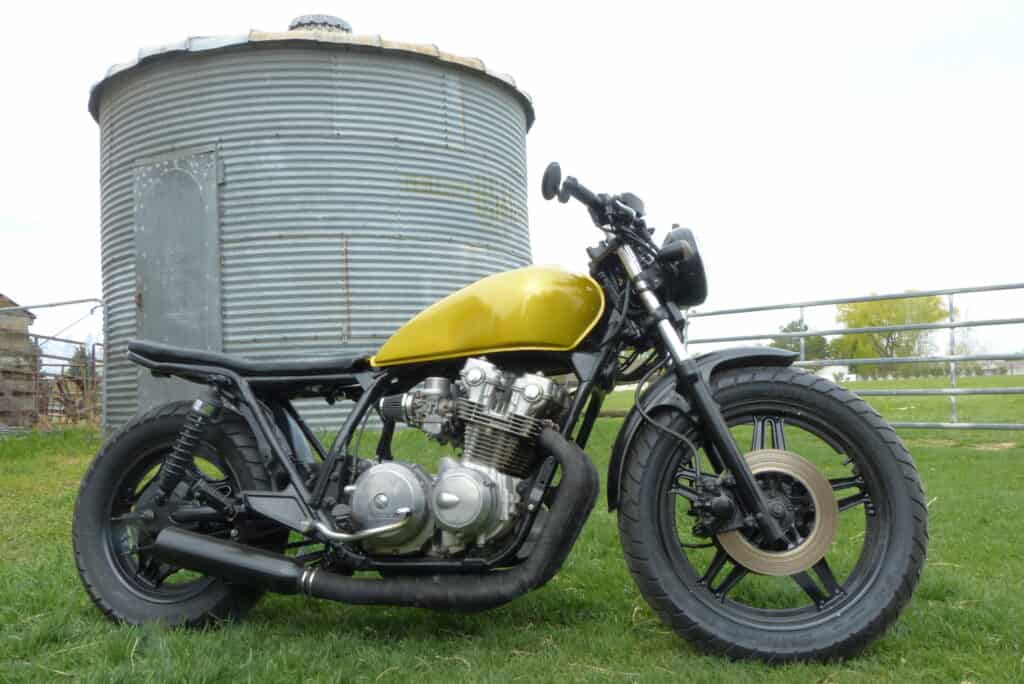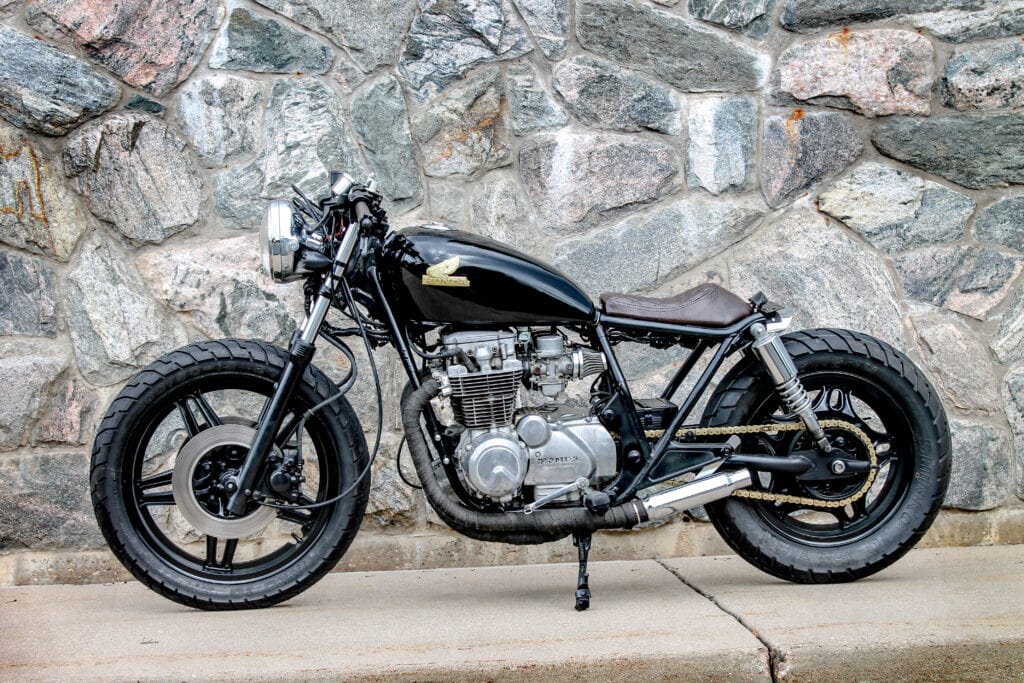
Some modifications on a motorcycle can impact the performance and some the visual appeal, but very few can really do both. A great way to improve the performance of a motorcycle engine is by managing the heat that is produced out of the cylinders. When an engine is able to disperse heat in a more efficient way, your engine will be less likely to lose power from a phenomenon called ‘heat soak’.
A real effective way to manage heat is a coated exhaust pipe. There are a lot of ways to manage the heat from an exhaust pipe, and some options are better than others, so it’s important to know the difference.
So, can you powder coat a motorcycle exhaust? It is possible to powder coat a motorcycle exhaust, though it’s a different process. A powder coating shop will have the correct coatings that will be able to effectively manage heat produced by an exhaust, but the coating that is used and recommended in the field is not a specifically powder coat, but rather a high heat ceramic coat.
A ceramic coating on your exhaust can really be the best of both worlds. It’s a great way to restore or protect the exhaust while at the same time becoming a stunning visual addition. In this article we’ll look at the different ways that you can protect motorcycle exhaust and the pros and cons that come from powder coating.
Using The Right Type Of Powder Coating
With a normal powder coating method, the part that is being painted is prepped and then covered in the desired color’s powder. Once covered in powder, the part is put in an oven around 400 degrees and then left in there for some amount of time. This heat helps the powder coating adhere to the metal surface and create a smooth glossy finish. There are plenty of downsides to using just a general purpose powder.
The first and most distinguished difference between powder coating and ceramic coating is the low heat levels the powder can withstand. With regular powder, the heat that it can withstand usually isn’t more than 400 degrees Fahrenheit.
I know that sounds like a lot, but sometimes your exhaust can reach temperatures that go in excess of 1200 degrees. This means that if you were to use a regular powder on the exhaust, under normal operating temperatures the powder would chip and burn off.
There are special types of powder coating methods that can be used to treat high temperature products. The wide range of these are known as ceramic coatings. The term ‘ceramic coatings’ is used in the automotive world relating to several different products, so it’s best to know which one you are talking about.
One type is used as a wax application on painted surfaces. The one that goes on the exhaust and on other high heat metals is often just referred to as “high-heat ceramic coatings.” Luckily, there are a lot of options out there that can help fit your needs, but it can all get pretty confusing and you’ll want to make sure that you get it done right.
In just about every city around the country you’re going to be able to find a professional powder coater to help you. Just about every professional powder coater you find will know all the details on how to coat just about every part of your motorcycle, as they will have likely already done it several times already.
Pros Of Powder Coating Motorcycle Exhaust

A lot of the pros that come from powder coating an exhaust is more than just heat management, but also has a lot to do with how much better it performs over other alternatives to a heat-treated coating.
To discuss a little about the benefit that comes from efficient heat management, every engine produces heat. As the piston goes up and compresses the air-fuel and then explodes down, heat is created and sent out through the exhaust pipe. The exhaust then carries the exploded gasses out the end of the tail pipe.
Standard exhaust can be very efficient and effective in doing this, but some of the materials that they are made out of are prone to heat soak. When the exhaust become hot, they can not efficiently transfer heat out the tail pipe.
What this means for the engine is that components that are nearer to the exhaust will start to become hot because of the heat that is coming off of the exhaust pipes. Maybe it’ll be the intake air temperature or the inside of the cylinders, or sometimes the catalytic converter. As these components get hot, they aren’t able to work as well and you’ll be able to notice a power decrease as the heat climbs too high.
What ceramic coatings offer is an effective way to ensure that the exhausts pipe don’t get too hot and in return don’t overheat other components of the engine.
Some of the other pros of a ceramic powder coating is that whatever is covered is also able to resist dirt or rust build up. As exhausts age they get dirty and the dirt can trap moisture, leading to rust formation, and with a properly coated exhaust, you are able to extend the life of that part. This is a major problem with other aftermarket exhaust coatings as they don’t protect against rust in the same way. Sometimes methods like wraps, if not installed correctly, can trap moisture and dirt in a way that might even accelerate the rusting process.
Just like with any modification to a motorcycle, there are some negative factors to consider.
Cons Of Powder Coating Motorcycle Exhaust
A major hurdle when looking at coating a motorcycle is the cost that it involves. It can get pretty expensive when it comes to involving a professional. Sometimes shops charge rates that are around 100 – 120 dollars an hour, and there aren’t a lot of DIY options when it comes to ceramic coatings.
The heat treating process requires temperatures around 700 degrees, and the tools to do that are generally only purchased by shops. This is a big reason that you pay professionals to have done right the first time. There are ways out there to lessen the cost. You can have the part removed before you get to the shop, and maybe have it mostly prepped so that you can limit the time that the shop needs to spend on it.
Every shop may charge something different, so it’s wise to shop around and see which one will provide you with the best bang for your buck. Some shops might have expertise in car and motorcycle coatings, so they might be the best place to start looking. With any project, costs can really start to get out of hand if you’re not ready. So do some research and save your money so that you can get a good high quality product. A mediocre job could mean another pricey trip to a professional because it didn’t last.
Alternatives To Powder Coating

There are a lot of alternatives out there, most of the decision comes down to what look you are going for. The biggest alternative to powder coatings are exhaust wraps.
An exhaust wrap is when you take the exhaust of a motorcycle and wrap high temperature fabric around it from front to back. This style is commonly found on chopper and cafe racer style bikes. I’ve used exhaust wrap on the majority of my cafe racer builds (almost two dozen at this point) and have found a lot of success with it.
It’s not as effective of a heat management method, but on the bikes that it will be found on, it’s used as an accented aesthetic piece. Click here to see my other article that discusses the pros and cons of exhaust wrap in more detail.
And there’s always the option to simply paint your exhaust by using high heat spray paint. This can work and is much more budget friendly, but it doesn’t look as good and will certainly not last near as long as a ceramic coating.
Whatever motorcycle you have, and whatever your goal is, you should be able to find a heat management method that works for you and your budget. Just make sure that you consider cost and effectiveness when looking at what to use.
Conclusion
Powder coating offers a durable and attractive option for customizing motorcycle exhaust systems. When we say powder coating exhaust on a motorcycle, it should be more referred to as ceramic coating.
While there are some considerations to take into account, such as heat resistance and surface preparation, ceramic coating can effectively protect exhaust components from corrosion, scratches, and fading. Have you guys ever tried any of these options with your motorcycle exhaust? What do you guys prefer?
